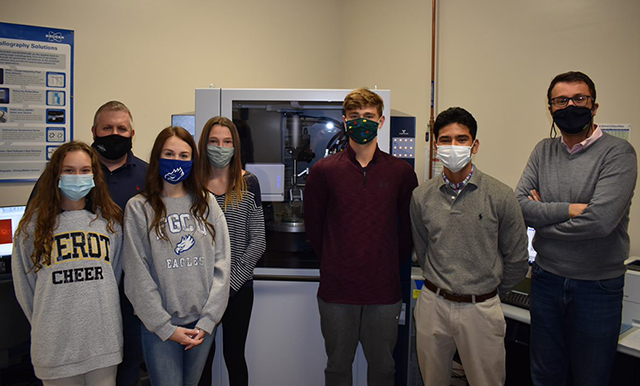The global pandemic will go down in history as the defining event of 2020. But it was also a year of extreme weather events that caught the attention of Florida Gulf Coast University researchers and their high school protégés.
Raging wildfires consumed large parts of the U.S. west coast and Australia. The Atlantic hurricane season ended with a record-breaking 30 named storms, forcing weather forecasters well into the Greek Alphabet to name them. The year 2020 is also on track to be one of the hottest on record, according to the World Meteorological Organization.

Inside a Seidler Hall chemistry research lab, FGCU researchers and four Southwest Florida high school students are taking on a high-level project to research and respond to this global issue.
“It is real and interesting cutting-edge research we are doing, but it is also a good learning tool for high school students and undergraduate students,” said Greg McManus, associate professor of chemistry.
In 2019, McManus and Arsalan Mirjafari, associate professor of chemistry, were awarded a Community Impact Grant for two years from the Southwest Florida Community Foundation to move this project forward. They are working to accomplish two goals. One is to develop technologies to help fight climate change, and the second is to train the next generation of chemists by involving them in a hands-on research experience.
“Before the coronavirus, I believe the major challenge the world was facing was climate change and global warming. We still have this issue, and we need innovative technologies to lead us to new climate change solutions,” explained Mirjafari.
With the help of the Whitaker Center at FGCU, McManus and Mirjafari sent out a call to Southwest Florida high schools in the five-county region for students to participate in the research; 27 applied and four were selected from Immokalee, Naples and Fort Myers.
One of the students selected is Cassidy Marino, a senior at Bishop Verot High School in Fort Myers with a knack for STEM (science, technology, engineering and math). This research is fueling her interest in chemistry.

“You don’t know what is going to happen when you mix a few things together,” said Marino. “You are just figuring it out as you go. That to me is so interesting and unique.”
The pandemic caused the team to meet virtually over the summer. They are back on track this fall, working alongside FGCU students and faculty in the lab. Together, they are developing materials that can selectively capture carbon dioxide (CO2) from the air. CO2 has been identified as one of the major culprits of climate change.
“I think it’s a unique opportunity for high school students to come into a university research lab and get this hands on experience, while working on a project that has a really big impact. They get to see every part of it,” explained Elizabeth Recker, an FGCU bioengineering research student working on this project.
With naturally occurring materials called amino acids, the team is developing a technology that will take CO2 directly from ambient air. It’s a process called direct air capture. The final product is liquid at room temperature but turns solid as it captures CO2 from the air.
“Within 20 minutes you can see with your eye how the liquids turn into solid, and over about four days is when we reach the maximum amount they can capture,” said Recker.
Eyes wide and eager to learn, the high school team members are soaking up every aspect of the internship. For some, it’s their first introduction to chemistry and the ability to apply what they have learned in school to a practical application.
“I honestly had no idea what we were going to be doing until I got there, but it’s more than I could have ever hoped for,” said Marino. “I thought it would be watching people do stuff or taking notes, but I am actually doing this science hands-on and the chemistry that is involved.”
As Marino prepares for college, she has a jump start on the STEM path as she continues to work at the university with state-of-the-art equipment. Now, she is considering majoring in biochemistry.
“Working with these people is obviously helping us academically and scientifically, but they are also really good with us personally,” she said, “They really do care about you as a person, which is awesome, because I can see myself talking to them in the future for guidance.”